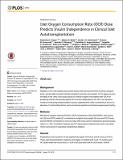| dc.contributor.author | Papas, Klearchos K. | |
| dc.contributor.author | Bellin, Melena D. | |
| dc.contributor.author | Sutherland, David E. R. | |
| dc.contributor.author | Suszynski, Thomas M. | |
| dc.contributor.author | Kitzmann, Jennifer P. | |
| dc.contributor.author | Avgoustiniatos, Efstathios S. | |
| dc.contributor.author | Gruessner, Angelika C. | |
| dc.contributor.author | Mueller, Kathryn R. | |
| dc.contributor.author | Beilman, Gregory J. | |
| dc.contributor.author | Balamurugan, Appakalai N. | |
| dc.contributor.author | Loganathan, Gopalakrishnan | |
| dc.contributor.author | Colton, Clark K. | |
| dc.contributor.author | Koulmanda, Maria | |
| dc.contributor.author | Weir, Gordon C. | |
| dc.contributor.author | Wilhelm, Josh J. | |
| dc.contributor.author | Qian, Dajun | |
| dc.contributor.author | Niland, Joyce C. | |
| dc.contributor.author | Hering, Bernhard J. | |
| dc.date.accessioned | 2015-08-20T18:51:27Z | |
| dc.date.available | 2015-08-20T18:51:27Z | |
| dc.date.issued | 2015-08 | |
| dc.date.submitted | 2015-07 | |
| dc.identifier.issn | 1932-6203 | |
| dc.identifier.uri | http://hdl.handle.net/1721.1/98167 | |
| dc.description.abstract | Background
Reliable in vitro islet quality assessment assays that can be performed routinely, prospectively, and are able to predict clinical transplant outcomes are needed. In this paper we present data on the utility of an assay based on cellular oxygen consumption rate (OCR) in predicting clinical islet autotransplant (IAT) insulin independence (II). IAT is an attractive model for evaluating characterization assays regarding their utility in predicting II due to an absence of confounding factors such as immune rejection and immunosuppressant toxicity.
Methods
Membrane integrity staining (FDA/PI), OCR normalized to DNA (OCR/DNA), islet equivalent (IE) and OCR (viable IE) normalized to recipient body weight (IE dose and OCR dose), and OCR/DNA normalized to islet size index (ISI) were used to characterize autoislet preparations (n = 35). Correlation between pre-IAT islet product characteristics and II was determined using receiver operating characteristic analysis.
Results
Preparations that resulted in II had significantly higher OCR dose and IE dose (p<0.001). These islet characterization methods were highly correlated with II at 6–12 months post-IAT (area-under-the-curve (AUC) = 0.94 for IE dose and 0.96 for OCR dose). FDA/PI (AUC = 0.49) and OCR/DNA (AUC = 0.58) did not correlate with II. OCR/DNA/ISI may have some utility in predicting outcome (AUC = 0.72).
Conclusions
Commonly used assays to determine whether a clinical islet preparation is of high quality prior to transplantation are greatly lacking in sensitivity and specificity. While IE dose is highly predictive, it does not take into account islet cell quality. OCR dose, which takes into consideration both islet cell quality and quantity, may enable a more accurate and prospective evaluation of clinical islet preparations. | en_US |
| dc.description.sponsorship | National Institutes of Health (U.S.) (Clinical Islet Transplantation Consortium Grant) | en_US |
| dc.description.sponsorship | Iscel Cell Resources (Grant) | en_US |
| dc.description.sponsorship | Carol Olson Memorial Diabetes Research Fund | en_US |
| dc.description.sponsorship | Schott Foundation | en_US |
| dc.description.sponsorship | Iacocca Foundation | en_US |
| dc.description.sponsorship | National Institute of Diabetes and Digestive and Kidney Diseases (U.S.) (K23 DK084315) | en_US |
| dc.language.iso | en_US | |
| dc.publisher | Public Library of Science | en_US |
| dc.relation.isversionof | http://dx.doi.org/10.1371/journal.pone.0134428 | en_US |
| dc.rights | Creative Commons Attribution | en_US |
| dc.rights.uri | http://creativecommons.org/licenses/by/4.0/ | en_US |
| dc.source | Public Library of Science | en_US |
| dc.title | Islet Oxygen Consumption Rate (OCR) Dose Predicts Insulin Independence in Clinical Islet Autotransplantation | en_US |
| dc.type | Article | en_US |
| dc.identifier.citation | Papas, Klearchos K., Melena D. Bellin, David E. R. Sutherland, Thomas M. Suszynski, Jennifer P. Kitzmann, Efstathios S. Avgoustiniatos, Angelika C. Gruessner, et al. “Islet Oxygen Consumption Rate (OCR) Dose Predicts Insulin Independence in Clinical Islet Autotransplantation.” Edited by Matthias G von Herrath. PLoS ONE 10, no. 8 (August 10, 2015): e0134428. | en_US |
| dc.contributor.department | Massachusetts Institute of Technology. Department of Chemical Engineering | en_US |
| dc.contributor.mitauthor | Colton, Clark K. | en_US |
| dc.relation.journal | PLOS ONE | en_US |
| dc.eprint.version | Final published version | en_US |
| dc.type.uri | http://purl.org/eprint/type/JournalArticle | en_US |
| eprint.status | http://purl.org/eprint/status/PeerReviewed | en_US |
| dspace.orderedauthors | Papas, Klearchos K.; Bellin, Melena D.; Sutherland, David E. R.; Suszynski, Thomas M.; Kitzmann, Jennifer P.; Avgoustiniatos, Efstathios S.; Gruessner, Angelika C.; Mueller, Kathryn R.; Beilman, Gregory J.; Balamurugan, Appakalai N.; Loganathan, Gopalakrishnan; Colton, Clark K.; Koulmanda, Maria; Weir, Gordon C.; Wilhelm, Josh J.; Qian, Dajun; Niland, Joyce C.; Hering, Bernhard J. | en_US |
| dc.identifier.orcid | https://orcid.org/0000-0001-8777-9632 | |
| mit.license | PUBLISHER_CC | en_US |
| mit.metadata.status | Complete | |
